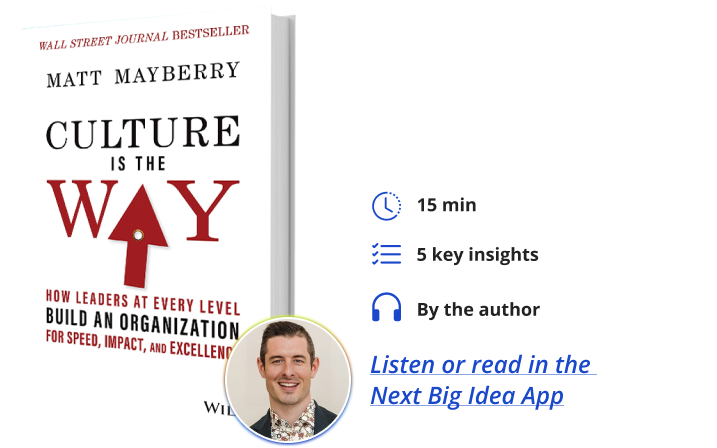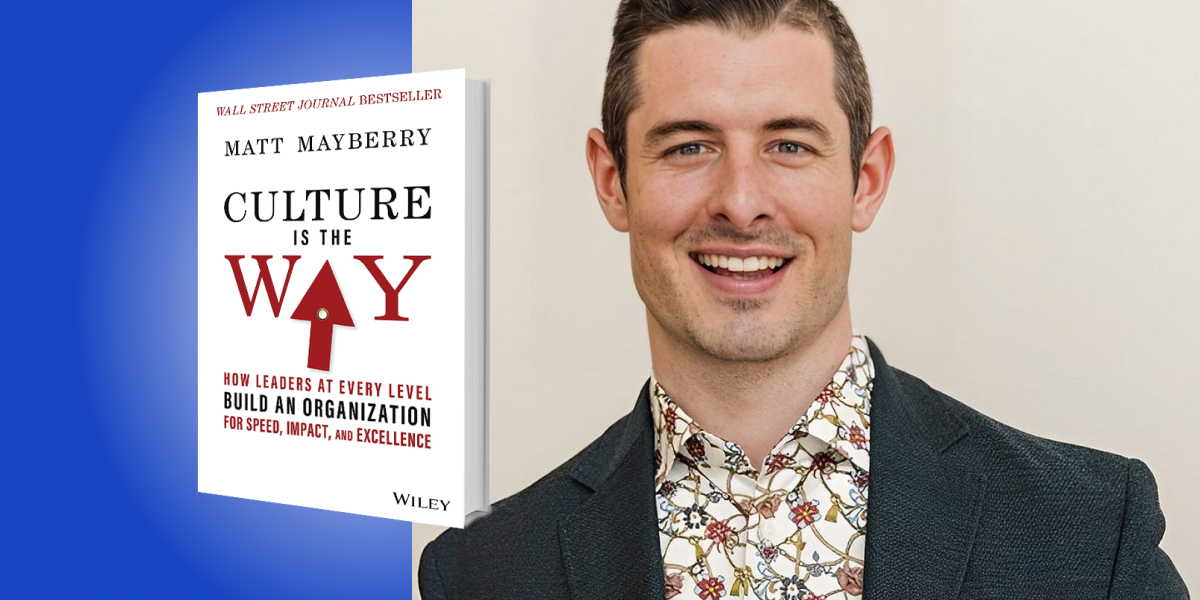Matt Mayberry is an internationally acclaimed keynote speaker and one of the world’s foremost thought leaders on leadership development and culture. His insights on leadership, culture, and business performance have appeared in publications such as Forbes, Fortune, Business Insider, Entrepreneur, NBC, ABC, Fox Business, and ESPN, to name but a few. Mayberry is a former American football linebacker for the Indiana Hoosiers and the Chicago Bears.
Below, Matt shares five key insights from his new book, Culture Is the Way: How Leaders at Every Level Build an Organization for Speed, Impact, and Excellence. Listen to the audio version—read by Matt himself—in the Next Big Idea App.

1. The power of culture.
Building a great workplace culture for your team or organization is no longer an added benefit. It’s a major organizational imperative and key to winning the competitive war for talent. Culture wields enormous power. It is the deciding factor that can not only create a dynamic, innovative workplace but also drive extraordinary levels of execution in the marketplace.
When it comes to culture, one of the most glaring issues is that far too many leaders do not recognize it as one of their greatest competitive advantages. And for the leaders who do see it as a competitive advantage, their daily actions often contradict this. Culture should not and cannot be an afterthought that is delegated to the HR department or some separate initiative. The best leaders see culture at the forefront of everything they do. “I came to see, in my time at IBM, that culture isn’t just one aspect of the game; it is the game,” former IBM CEO Lou Gerstner said.
Your strategy can be stolen and copied by the competition. They can mimic your sales process and clone the vast majority of your company’s daily operations. The culture you create is something no one can take away or imitate.
Culture has a powerful impact on business performance, particularly when management is focused on integrating its culture into every aspect of the business. A Harvard University study found that companies with a strong and healthy culture experienced a 756 percent increase in net income compared to those with a weaker culture. Even if that number is slightly inflated, it still represents a staggering level of growth. The power of culture truly is extraordinary.
2. What culture is and what it is not.
Culture is the lifeblood of organizational excellence. The core. The energy. The genetic code. It is front and center for leaders who want to improve performance and strategic alignment. It is an organization’s heart and soul.
Simply put, it is how well an organization does everything behind closed doors. When you see a high-performing organization that achieves excellence in nearly every aspect of its operations, it is a company with an exceptional commitment to fostering and enhancing its culture. The deep-seated purpose of an organization, what it does daily, and the level of impact it has internally and externally are all aspects of its culture. Regardless of what a leader declares their organizational culture to be, the deciding factor lies in the collective mindsets, repeated efforts and actions, and consistent results experienced both inside and outside the organization.
“The deep-seated purpose of an organization, what it does daily, and the level of impact it has internally and externally are all aspects of its culture.”
Everyone interprets organizational culture differently. One of the most obvious misconceptions about culture is the context in which it is defined. It is nearly impossible to build a great culture if you believe that it entails gathering the senior leadership team for an offsite retreat to develop new core mandates and then plastering those values throughout sales offices and headquarters. It goes much deeper than that.
- Culture is not the flexibility to work three days per week.
- Culture is not wearing whatever you want to work.
- Culture is not having the liberty to do whatever you want.
- Culture is not having a manager who never holds you accountable or challenges you.
- Culture is not reciting the company’s mission statement at team meetings.
- Culture is not having fun games in the office.
- Culture is not supposed to make everyone happy.
When these examples above are mistaken for what culture stands for, they can be detrimental. I am not suggesting that perks and the examples shared are bad because once you’ve laid a solid foundation for the culture you want to build, it’s critical to create an environment where people want to work every day. The issue has nothing to do with the perks. The problem arises when leaders believe that culture is defined by how many perks that they can offer or how cute the core values are.
3. Beware of shiny object syndrome.
The culture dilemma that sabotages most culture-building efforts is leaders that have become convinced that there is something more significant that they should be paying attention to instead of culture. There are many shiny objects in every organization, and leaders are quick to believe that attacking or embracing that next shiny object with decisive action is the surest path to growth. They often overlook the simple things that can propel them to success. Shiny objects consist of more than action items and operating procedures. Certain mindsets and beliefs can also take the form of shiny objects. Here are a few examples:
- The new and exhilarating technology system that was recently installed which is supposedly going to increase the productivity of the salesforce by 25 percent.
- A new HR tracking system which will enhance the efficiency of the candidate pool.
- A detailed list of one hundred initiatives leaders must complete by the end of the year in response to the employee survey results that came back a month ago.
- Run an offsite leadership retreat to refine the company’s strategy.
- Rigorously track sales and revenue every month and do whatever it takes to hit the numbers.
- Resting on laurels and continuing to do the same thing when things are going great, thinking that the same result will continue to repeat.
Some of the listed examples are essential for a high-performing organization. However, many of these shiny objects cause leaders to become blind. They are quick to jump from one shiny object to the next, believing that it will fill the void left by where they should really be spending their time: developing and growing their culture.
“Leaders are quick to believe that attacking or embracing that next shiny object with decisive action is the surest path to growth.”
The paradox of shiny object syndrome is that culture is the fundamental building block that enables an organization to execute virtually everything else, including many of the shiny objects.
4. Building a world-class culture.
There is no one-size-fits-all solution for improving an organization’s culture. Each organization is unique, with specific needs and areas for development. I’ve been involved in hundreds of instances over the last decade in which business leaders desperately seek the most effective way to improve culture. So, after years of experimenting, obsessive research, and merging key learnings from my days as an athlete on the football field, I formulated five stages for building and sustaining a world-class culture.
Step One: Define your culture. If you ask a group of people who appear to work for the same company, “What is the culture of your company?” most likely, each respondent will have a different answer. In thriving and world-class enterprises, everyone knows what the culture is, what it stands for, and what’s expected of them.
Step Two: Discovery through collaboration and inspiration. The discovery phase focuses on a collaborative and inspirational approach that engages the entire organization in the culture-building process. Senior leaders will partner with all managers, soliciting specific feedback to encourage and highlight valuable employee input. Collaboration between senior leadership and all the people managers has an increased impact when the process shifts to a bottom-up approach. As important as senior leaders are when it comes to large-scale change, this collaborative approach is more effective because it inspires managers and other key stakeholders to become more committed.
Step Three: Launch, cascade, and embed. It is detrimental if culture does not trickle down from the top and permeate all departments. Many leaders and people managers believe that it is enough if a company has strong core values and defines its culture openly. But it isn’t. Leaders must make it a priority to disseminate it across the entire organization. This stage is all about relentlessly implementing culture and embedding it across all functions.
Step Four: Drive long-term impact. It is one thing to create a momentary buzz about your culture; it is quite another to create a culture that embodies the core DNA of your organization. Some businesses may see instant results from a one-time advertising campaign, but the true test is whether those businesses can produce ongoing innovation and long-term impact. This stage helps develop a strategy for creating a sustainable culture that consistently delivers.
Step Five: Leaders must blaze the trail. This final stage is a deciding factor in whether an organization succeeds or fails at creating a world-class culture. It all comes down to how well leaders model the way forward, practice what they preach daily, set clear cultural expectations for everyone, and blaze the trail forward. What leaders do on a regular basis sends a strong message to the rest of the organization.
5. Becoming a Chief Culture Driver.
When you make the decision to be a Chief Culture Driver, you’re not just beginning the process of building a better organization or achieving better business results. You are also manifesting changes that will impact how you lead and interact with others. This is the humanity factor. The hearts and minds factor. The psychological safety factor.
“Even with technological and AI advancements, people are still the center of nearly everything an organization does.”
The more your people—leaders, managers, and employees—thrive, the more your business thrives. When your employees’ lives are positively shaped as a result of where they work and with whom they work, the organization’s performance increases.
Great cultures take time and effort to cultivate from within. That involves something deeper than simply hard work and great ideas. It requires the heart of it all: people. Who is responsible for hitting the numbers and making sure everything goes as planned? People. Who is in charge of coming up with a winning strategy and seeing it through to completion? People. When it comes to product design, marketing, and sales, who is responsible? People. Who makes up the culture of an organization? People. Even with technological and AI advancements, people are still the center of nearly everything an organization does.
To listen to the audio version read by author Matt Mayberry, download the Next Big Idea App today:





























